
TABLE OF CONTENTS:
Best Handling Practices
Hook Removal Techniques
Weighing Your Trophy
Measuring Your Trophy
Best Live Well Practices
Release Tips

Florida bass can live for weeks without food but only seconds without oxygen. The most important thing you can do for your bass is allow it to breathe oxygen from the water.

- Keep documentation tools (scale, camera, measuring board) readily available.
- Set the hook quickly to avoid deeply hooked bass.
- Land the bass as quickly as possible. The longer a fish fights the more potential stress and exhaustion it undergoes.
- Use a soft, knotless landing net.
- Remove the hook while the bass is in the water if possible.
- Use de-hooking tools and heavy cutters to cut and remove hooks. See Hook Removal Techniques for more information.
- Keep the bass in water while you prepare your documentation tools. Consider using an aerated live well or in the absence of a live well (e.g., canoe/kayak, jon boat without any plumbing, etc.), leave the bass on the hook temporarily, leave the bass in a submersed landing net, or place the bass in a large enough water-filled cooler until you are ready. This will aid in achieving a healthy release of your fish.
- Do not hold a bass in a live well for extended periods. This unnecessarily stresses the fish and can lead to delayed mortality.
- Wet all objects/surfaces that will be in contact with the bass including your hands, measuring board, or scale to protect the bass' slime coat. Do not place fish on hot, dry, or rough surfaces such as a metal boat floor, concrete, grass, dry towel or dry carpet.

- Handle the bass only when measuring (length and girth), weighing, photographing, and placing in it a live well.
- When documenting your catch, avoid keeping the bass out of water for more than 30 seconds at a time (approximately as long as you can hold your own breath). See Weighing Your Trophy and Measuring Your Trophy for more information.
- Keep the bass near the location where you caught it to ensure a quick release.
- When releasing the fish, place it gently in the water headfirst, and use your other hand to support its belly. If necessary, move the fish in a gentle figure eight to pass water over the gills (do not pull it backwards). See Release Tips for more information.


- When possible, use circle or barbless hooks to limit deep hooking.
- Use de-hooking tools to avoid damaging gills or other parts of the fish's mouth.
- Hook location may vary, having several types of de-hooking tools handy will be helpful.

- Deep Hook Removal:
- Cut the line and gently pull the shank to reverse the hook. See below images.
- If the fish is large enough, maneuver the hook through the gill opening.
- Using pliers or de-hookers, gently remove the hook.
- The approach to deep hook removal may require more time than simply cutting the line close to the hook eye. Use your judgement prior to considering deep hook removal if you are not an expert.
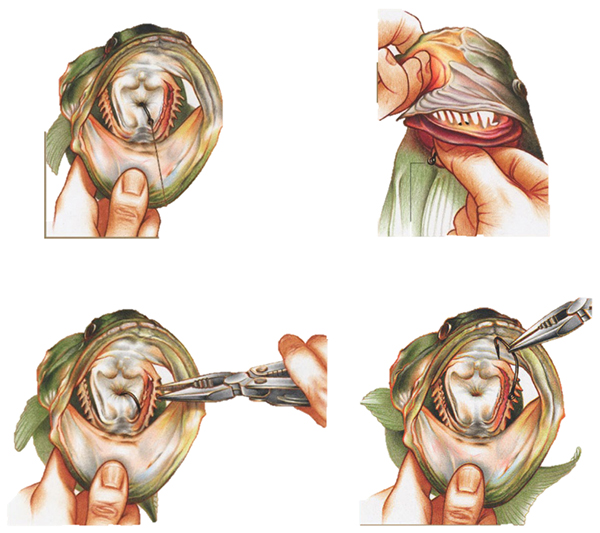
Graphic from B.A.S.S. "Keeping Bass Alive." Used with permission.
- Deep Hooked Bass:
- Removal of a deep hook may require the fish to be out of water for a long time or cause further physical injury to the fish.
- If the hook cannot be removed quickly and easily, leaving the hook in place and cutting the line as close to the hook as possible can give your bass a better chance at survival and may be the best option to reduce stress and injury to the fish. Studies have shown that bass can shed deep hooks through time.
- If the hook is cut and left in the bass' mouth, remove any soft plastic lure that may be attached to the hook.
- If soft plastic lures are not removed and get ingested by the bass they could remain in the stomach and lead to potential starvation.
- Soft plastic baits do not degrade well over time and absorb water and swell up. Furthermore, anglers should do their best to avoid having any used or discarded soft plastic bait left in the water, where they could be eaten by fish or wildlife.


Be prepared and understand how to read your scale
- Have a functional scale on your person or handy in the boat and be familiar with its operation. There are several types of weighing scales (e.g., digital, spring, pan) available to anglers, and within those common styles of scales there are potentially hundreds of different models. Weights can be displayed in several different units (e.g., pounds ounces, grams) so we recommend that anglers familiarize themselves with their scale(s) and read through the manufacturer's user manual.
- Some digital scales display weight in pounds and ounces. Pounds are displayed first and often "LB" is listed next to the number and ounces are displayed second and often "OZ" is listed next to the number. Frequently, a large space or colon also separates pounds and ounces. The scales in the photos below display 8 pounds 4 ounces (8.25 pounds).
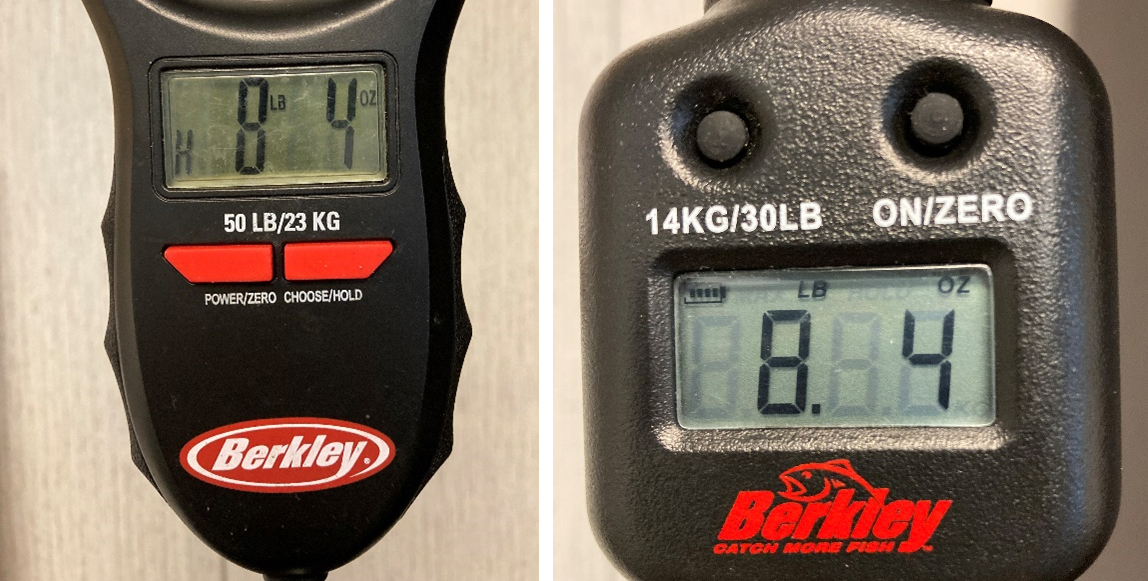
- Some digital scales display weight in pounds and decimal pounds. Usually just "LB" is listed on the screen next to the numbers. In the photo below, 8.24 lbs could also be recorded as 8 pounds 4 ounces (0.25 pounds).

- The BogaGrip scale (Model 130) measures in half-pound increments. The numbers on the scale representing the weight of the fish are displayed below the respective line. This scale example is displaying 14.5 lbs. We can see the "14" on the right side below the line representing 14 pounds and the indicator is resting on the increment above this (14.5).
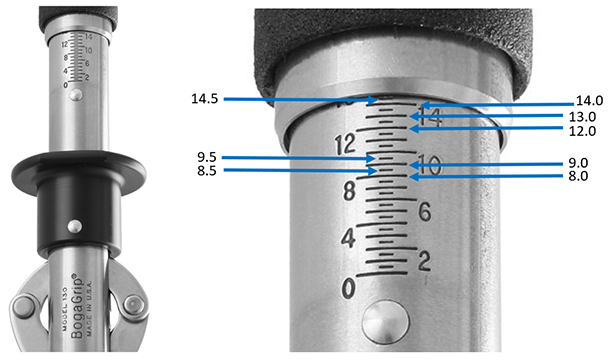
- This table shows the conversion from ounces to decimal pounds. For instance, an 8.06-pound bass could also be reported as 8 pounds 1 ounce. 16 ounces = 1.00 pound. This information can also be found on the TrophyCatch Submission Form via a drop down menu.
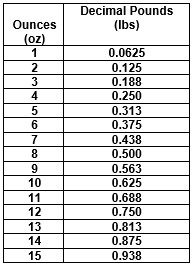
Methods of weighing your bass
- Keep your bass in the water by any means possible (e.g. live well, knotless landing net) while you get your scale ready to weigh the fish.
- It is preferred that no additional holes are punched in the fish's mouth membranes as this could lead to infection or injury. Multiple types of hanging scales achieve this by gripping the bass' jaw for a quick weighing.

- Pan scales do not require any perforations either and support the weight of the bass across a larger area. These are the type of scales that FWC biologists use. Be sure to wet and cool the surface before weighing the bass. Place basket on the scale prior to zeroing out the scale and weighing your bass. Be sure that the entire weigh pan, scale, and fish are included in the photo/video.
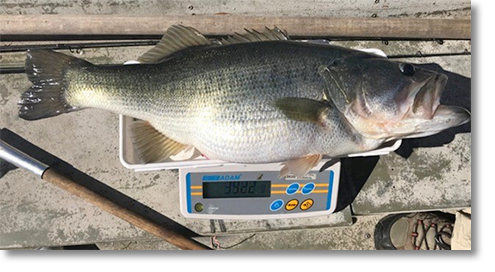
- "Hook-style" hanging scales have been the mainstay for recreational anglers weighing bass for years. They generally require suspending a bass from the isthmus (the "V" under the jaw) or by punching a small hole in the mouth membranes. Anglers should minimize the size of the hole if using this method and avoid puncturing locations that will further tear when the weight of the bass is fully supported. If suspending a bass from the isthmus, anglers should be careful not to hook and support a bass from its gill arch. Hanging a fish from a gill arch could damage fragile tissues located here and cause the fish to bleed, possibly resulting in death.

- Many hook-style scales can easily be modified with the addition of a lip-gripper, which eliminates the need to punch holes or suspend fish from sensitive locations near the gill arches.

- Avoid suspending bass from oversized hooks. This may create a large hole in the mouth membrane. These wounds compromise a bass' ability to feed and open the door for pathogen infection.


- Store the measuring board in an easily accessible location out of the sun to keep it cool.
- Use a cool, wet, smooth surface to support your fish while measuring. Good measuring boards come in a variety of materials (e.g., plastic, plexiglass, wood).
- Make sure to wet your hands and the measuring board with water to help cool the measuring surface and help protect the slime coat while handling the fish.
- Use your wet hands to gently secure the fish on the board to prevent the fish from flopping around and potentially falling.
- With the fish's mouth closed, make sure the tip of the bass' nose is touching the zero end of the measuring board or tape measure.
- Lay the bass flat and straight on the measuring board or tape.
- Pinch the bass' tail (aka, caudal fin) to get an accurate total length.
- If a smooth surface is not available for measuring your fish, at least make sure that it is cool and wet.
- If measuring girth, run a soft tape measure around the widest point of the fish (perpendicular to the length). Keep the tape snug against the fish's body. The point at which the tape overlaps itself is the girth measurement.
- Other items (e.g., string or fishing line) may be used to measure girth. If using a piece of string, note the point of overlap and measure the distance between the two points with a ruler.
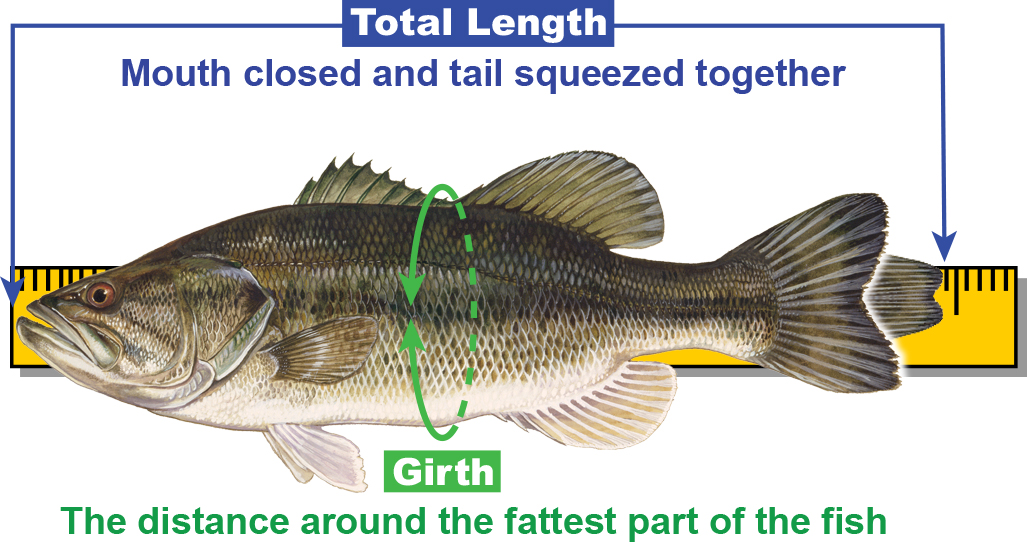
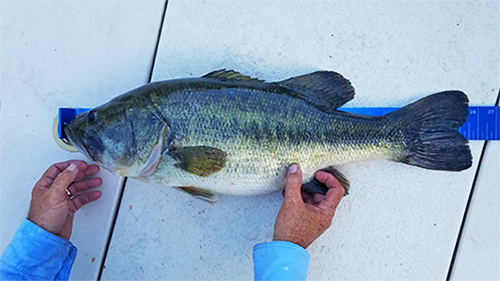
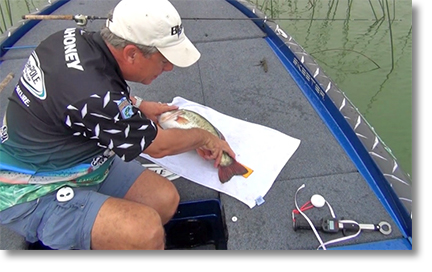
- NOTE: All anglers who submit a Hall of Fame (13+ lbs.) bass that includes a length photograph will win an additional $50 Bass Pro Shops gift card if their catch is approved.
- Length documentation photos should follow these guidelines and example photos:
- Wet the measuring board or surface to protect the bass' slime coat.
- Position the bass lying flat on a flat surface or measuring board.
- The measuring board can be beneath the bass OR immediately adjacent to it (above or below).
- If the bass is on the measuring board, measurement increments should be visible on each end.
- Center the camera above the bass at a 3 feet or higher.
- Double check your length photos to make sure the length readings are easily legible.
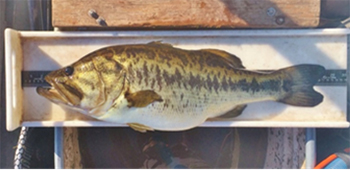
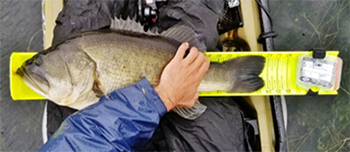
- Never measure fish on hot or dry surfaces (i.e., pavement, metal boat floors, ground). Doing this can remove the slime coat which protects the fish from infection.
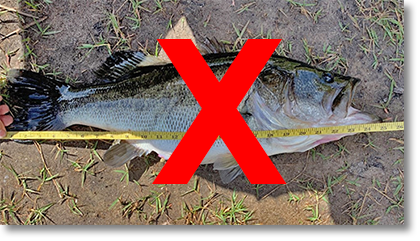


- Do not crowd bass or hold a bass for extended periods in the live well. This unnecessarily stresses the bass out and can lead to delayed mortality.
- Fill your live well with clean water from the waterbody you are fishing. Recirculate or aerate the live well to maintain sufficient oxygen.
- Do not place bass in chlorinated tap water.
- Do not place bass in warmer live well water than the waterbody they were caught in.
- Keep track of the water temperature (warmer water holds less oxygen). Bass need more oxygen and excrete more waste during warmer months.
- Many of the above live well practices match the Official FWC recommendations for tournament anglers and improving bass survival and can be found here: Keeping Bass Alive | Bassmaster.


- When releasing your bass, place it carefully in the water headfirst.
- If the bass needs some reviving, support the bass' weight by placing your hand under its belly and the other under the tail to recover until it has regained its balance and strength to swim away on its own.
- If necessary, gently move the bass forward or in a slow figure eight to pass water over the gills.
- Refrain from moving the bass backward because the fish takes water in through the mouth which then flows over the gills, bringing the fish oxygen. When the fish is moved backwards it makes the flow of oxygen to the fish more difficult.
- Attempt to release your bass in cooler, clearer, more highly oxygenated water to reduce stress.

Thank you for taking the time to take care of your bass, and thanks also to our conservation partners including Bass Pro Shops who make TrophyCatch possible!

Scale images are from Berkley and BogaGrip. Bass graphics by Duane Raver, Jr.
